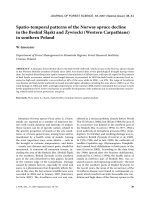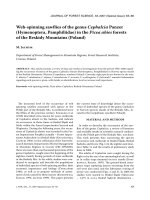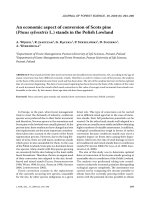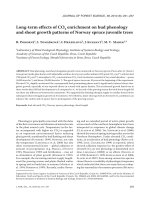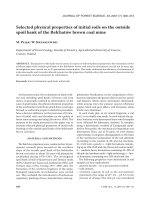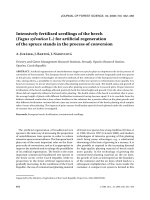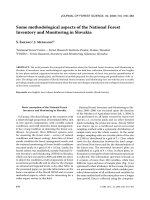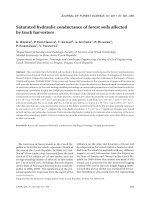Báo cáo lâm nghiệp: "Changing electrophoretic patterns of glutamate dehydrogenases and aspartate aminotransferases in a few tree species under the influence of ectomycorrhization" potx
Bạn đang xem bản rút gọn của tài liệu. Xem và tải ngay bản đầy đủ của tài liệu tại đây (148.35 KB, 3 trang )
Changing
electrophoretic
patterns
of
glutamate
dehydro-
genases
and
aspartate
aminotransferases
in
a
few
tree
species
under
the
influence
of
ectomycorrhization
B. Botton
M.
Chalot
1
B.
Dell
2
1
Universit6
de
Nancy
I,
Facult6
des
Sciences,
Laboratoire
de
Physiologie
V6g6tale
et
Forestiere,
BP
239,
54506
Vandceuvre-les-Nancy
Cedex,
France,
and
2
Murdoch
University,
School
of
Biological
and
Environmental
Sciences,
Murdoch,
Western
Austra-
lia,
6150
Australia
Introduction
Numerous
studies
have
demonstrated
the
widespread
existence
of
two
systems
for
nitrogen
assimilation
in
plants
and
microorganisms:
the
glutamate
dehydro-
genase
(GDH)
pathway
and
the
glutamine
synthetase
(GS)/glutamate
synthase
(GOGAT)
cycle.
While
the
GS/GOGAT
pathway
is
operative
in
higher
plants
(Lea
and
Miflin,
1974),
ammonia
assimilation
in
fungi
generally
occurs
via
the
GDH
pathway
(Pateman
and
Kinghorn,
1975),
although
some
non-mycorrhizal
fungi
seem
capable
of
utilizing
the
alternative
glutamine
synthetase/glutamate
synthase
route
(Kusnan
et al.,
1987).
In
mycorrhizal
associations,
preliminary
data
have
shown
that
the
fungal
pathways
of
nitrogen
as-
similation
in
beech-mycorrhizas
are
modi-
fied
by
the
establishment
of
the
symbiosis
and
that
glutamate
dehydrogenase
plays
a
minor
role
in
this
process
(Martin
et
al.,
1986).
Taking
these
observations
into
account,
we
studied
a
few
ectomycorrhizal
associations,
focusing
on
GDH
and
aspar-
tate
aminotransferase
(AAT),
an
enzyme
which
converts
glutamate
into
aspartate.
Materials
and
Methods
Norway
spruce
(Picea
excelsa)
roots
and
Hebeloma
sp.
ectomycorrhizas
were
obtained
from
4
yr
old
plants
grown
under
nursery
condi-
tions.
Douglas
fir
(Pseudotsuga
douglasii )
roots
either
non-mycorrhizal
or
ectomycorrhizal
with
Laccaria
laccata
(strain
S
238)
were
collected
from
1
yr
old
seedlings
grown
under
nursery
conditions.
Beech
(Fagus
sylvatica)
roots
and
Paxillus
involutus
(Naudet
strain)
ectomycorrhi-
zas
as
well
as
Hebeloma
crustuliniforme
ecto-
mycorrhizas
were
collected
from
4-6
mo
old
seedlings
grown
in
a
pasteurized
peat
mix
under
nursery
conditions.
The
fungi
were
culti-
vated
in
pure
culture
in
Pachlewski’s
medium.
Enzyme
activities
and
protein
concentration
were
determined
according
to
methods
de-
scribed
elsewhere
(Khalid
et
al.,
1988;
Dell
et
al.,
1989).
Electrophoresis
was
carried
out
on
6%
polyacrylamide
slab
gels.
The
bands
of
NADP-GDH
and
NAD-GDH
activities
were
lo-
cated
by
using
a
tetrazolium
assay
system
(Blu-
menthal
and
Smith,
1973)
and
AAT
activity
was
revealed
with
Fast
violet
blue
(Khalid
et
aL,
1988).
Results
In
the
free-living
fungus
Hebeloma
sp.
a
high
level
of
NADP-GDH
activity
was
found,
whereas
only
NAD-GDH
activity
was
detected
in
non-mycorrhizal
roots.
In
the
association
spruce-Hebefoma,
both
activities
were
present
(Table
I).
A
similar
distribution
of
enzyme
activities
was
observed
in
the
Douglas
fir-L.
laccata
association
(not
shown).
These
results
contrast
with
those
ob-
tained
with
Beech
ectomycorrhizas
where
NADP-specific
activity
was
very
low
(Table
I).
Identical
data
were
also
obtained
with
the
associations
beech-P.
involutus
and
Beech-H.
crustuliniforme
(not
shown).
In
the
Spruce-Hebeloma
sp.
associa-
tion,
gel
electrophoresis
confirmed
the
presence
of
NAD-GDH
in
the
host
cells
(one
band)
and
the
presence
of
a
high
level
of
NADP-GDH
activity
in
the
fungus
(one
major
band
and
one
minor
band).
Both
GDHs
were
detected
in
spruce
ecto-
mycorrhizas
(Fig.
1 A).
In
the
Beech-H.
crustuliniforme
association,
the
single
band
of
NADP-GDH
activity
found
in
the
fungus
was
represented
as
traces
in
the
mycorrhiza,
which
exhibited
a
high
level
of
NAD-GDH
activity
as
did
the
non-mycor-
rhizal
roots
(Fig.
1
B).
As
for
aspartate
aminotransferase,
the
distinct
isoforms
found
in
mycorrhizas,
always
corresponded
to
the
host
root
iso-
forms,
whereas
the
fungal
form
found
in
the
fungus
cultivated
in
pure
culture
was
not
detected.
Dissection
of
the
mycorrhizal
tissues
in
spruce
confirmed
these
results:
the
vascular
cylinder
free
of
fungus
and
the
cortical
region
including
host
cells
and
fungal
hyphae
revealed
identical
isoforms,
while
no
activity
was
found
in
the
peri-
pheral
mycelial
layer
(Table
II).
Conclusion
In
all
the
associations
investigated,
fungal
AAT
was
strongly
repressed,
whereas
fun-
gal
NADP-GDH
was
only
repressed
in
beech!ctomycorrhizas.
These
results
suggest
that
the
repression
may
come
from
the
host
plant,
since
the
same
fungus
gives
rise
to
two
kinds
of
responses
de-
pending
upon
the
plants.
However,
to
date,
the
mechanism
of
repression
remains
unknown.
References
Blumenthal
K.H.
&
Smith
E.L.
(1973)
Nicotina-
mide
adenine
dinucleotide
phosphate-specific
glutamate
dehydrogenase
of
Neurospora.
J.
Biol.
Chem.
248,
6002-6008
Dell
B.,
Botton
B.,
Martin
F.
&
Le
Tacon
F.
(1989)
Glutama
1
le
dehydrogenases
in
ectomy-
corrhizas
of
spruce
(Picea
excelsa
L.)
and
beech
(Fagus
sylvatica
L.).
New
Phytol.
111,
683-692
Khalid
A.,
Boukroute
A.,
Botton
B.
&
Martin
F.
(1988)
The
aspartate
aminotransferase
of
the
ectomycorrhizal
fungus
Cenococcum
geophi-
lum:
purification
and
molecular
properties.
Plant
Physiol.
Biochem.
26, 17-28
Kusnan
M.B.,
Berger
M.G.
&
Fock
H.P.
(1987)
The
involvement
of
glutamine
synthetase/gluta-
mate
synthase
in
ammonia
assimilation
by
Aspergillus
nidulans.
J.
Gen.
Microbiol.
123,
1235-1242
Lea
P.J.
&
Miflin
B.B.
(1974)
An
alternative
route
for
nitrogen
assimilation
in
higher
plants.
Nature
251,
614-616
6
Martin
F.,
Stewart
G.R.,
Genetet
1.
&
Le
Tacon
F.
(1986)
Assimilation
of
15NH
4+
by
beech
(Fagus
sylvatica
L.)
ectomycorrhizas.
New
Phytol.
102, 85-94
Pateman
J.A.
&
Kinghorn
J.R.
(1975)
Nitrogen
metabolism.
In:
The
Filamentous
Fungi.
Vol.
2,
(Smith
J.E.
&
Berry
D.R.,
eds.).
Edward
Arnold,
London,
pp.
159-237

